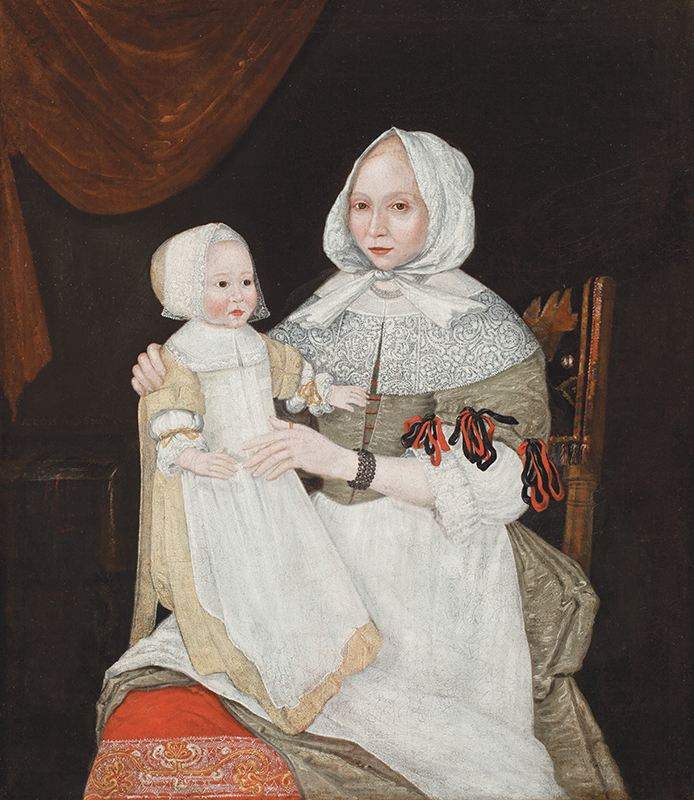
Most surveys of American art open with an illustration of Mrs. Freake and Baby Mary (Fig. 6), which is generally regarded as the finest American painting of the seventeenth century. In an article of 1964, Louisa Dresser, then the leading authority on seventeenth century American portraits, described the seventeenth century painting as a “masterpiece,” and declared that “it is not only the outstanding work” of the seventeenth century in this country but also “one of the great American paintings of any period.”1
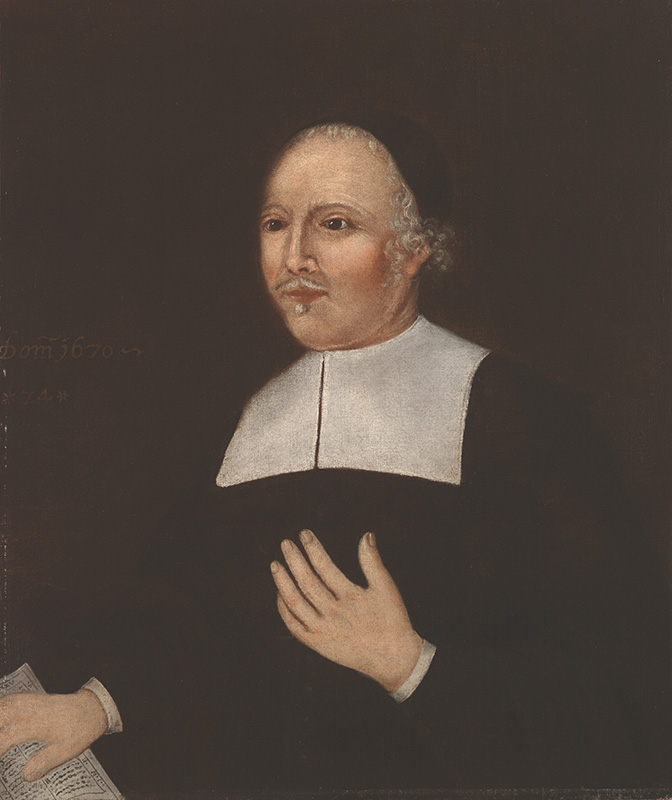
For all the fame of this work of art, however, its authorship has never been established. For the last century its author has simply been christened “The Freake Limner” after his best-known surviving work. The goal of this essay is to propose a solution to this mystery. By laying out what is known about this master, and organizing the clues imbedded within this evidence, we can come to a plausible conclusion about this artist’s name and identity.2
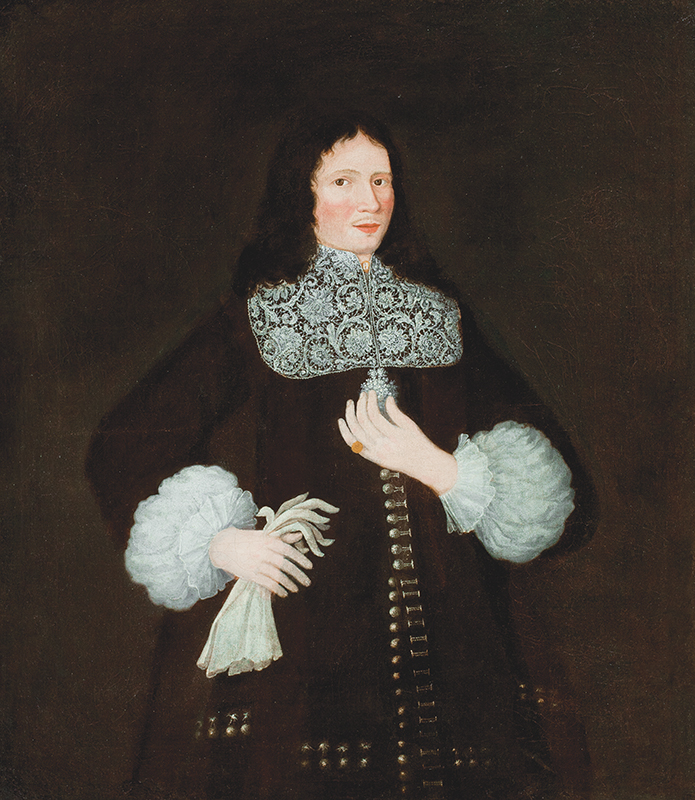
At first it may seem surprising that a work so widely reproduced has remained anonymous. But special difficulties surround the study of seventeenth century American painting. For one thing, many seventeenth-century America paintings have been so extensively restored that they bear little relation to their original appearance. A case in point is a portrait of John Bailley (Fig. 1.), who came to Boston in 1684 and served as assistant at the Old South Church. The image as it stands today shows a rather dreamy clergyman, gesturing with his proper right hand and looking out towards the viewer’s right. But an x-ray of the painting (Fig. 2), shows “a confusion of brushstrokes” which reveals that the present surface is entirely repainted, and that the original painting showed the subject’s nose pointing in the opposite direction. This evidence of drastic changes makes us wonder whether he originally looked so dreamy–or indeed, whether he bore any resemblance at all to the painting now on the surface. As Louisa Dresser has noted, “So great are the changes that the portrait as it stands to-day can hardly be called a seventeenth century likeness.”3 In other words, a constant challenge in studying the paintings and artifacts of this period is to determine how much is original, and how much is restoration and thus not usable as evidence.
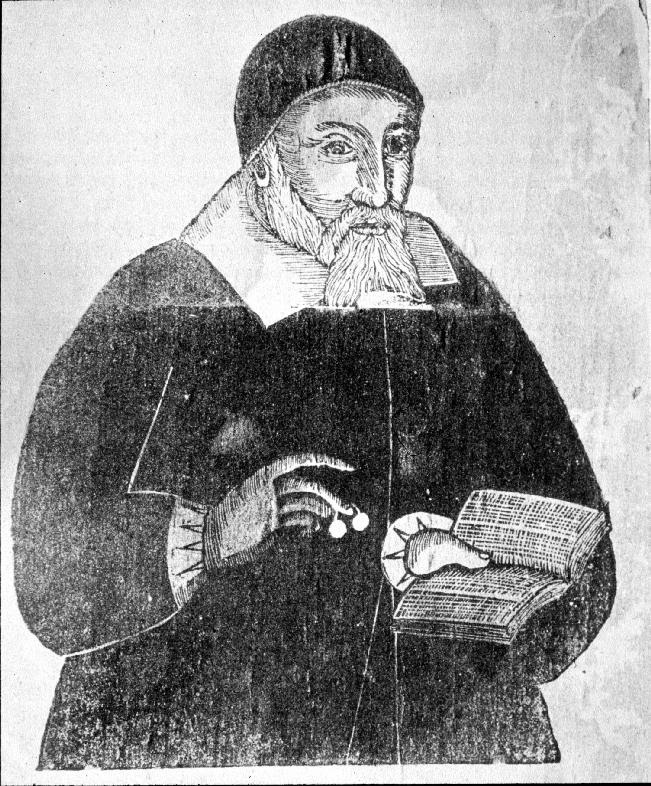
Even when paintings survive in good condition, the so-called “facts” associated with them are often curiously slippery. Paintings are almost never mentioned in seventeenth-century documents, and when they are if it is often difficult to tell whether the painting can be identified with one which is still extant. Family tradition about these early works of art is often highly misleading.
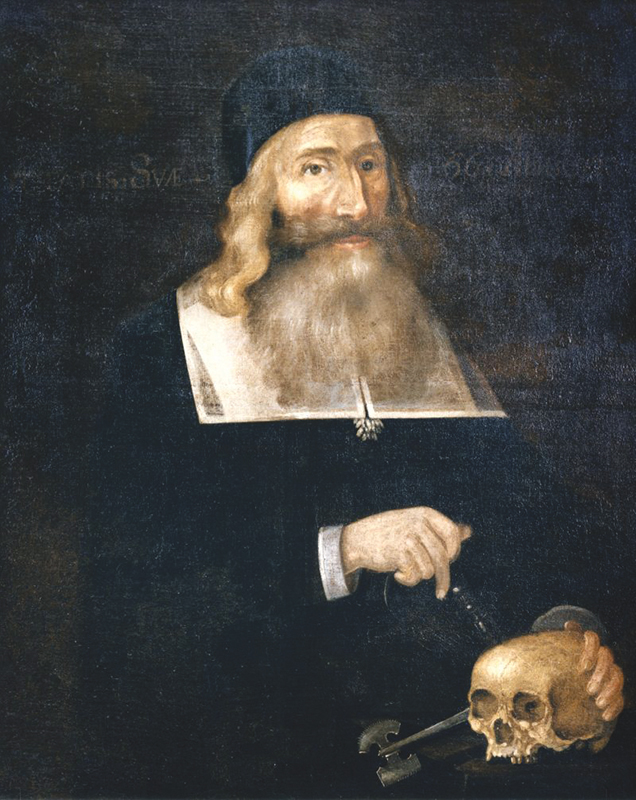
Thus, for example, one of the most charming seventeenth-century American paintings to survive is a portrait of a child of two or three years old which passed down to Abigail Adams, the wife U.S. President John Adams. It now belongs to the Adams National Historic Site in Quincy. Several generations of the Adams family, starting with President John Adams, believed that this piece represented John Quincy, the founder of the town of Quincy. But since the painting is dated to 1670 and Quincy was born in 1689, clearly this identification is incorrect.

Scholars now agree that this canvas represents Alice Mason, the little sister of David, Joanna, and Abigail Mason. (As will be discussed in more detail, shortly, these three older siblings appear in a remarkable group portrait, now in the Fine Arts Museums of San Francisco, which was executed by the same painter in the same year). Thus, the Adams family managed to confuse not only the identity of the sitter, but her sex–a fairly easy mistake to make with seventeenth-century portraits, since during the period both girls and boys wore dresses until the ages of four or five. The confusion came about because the painting passed down to the Adams family from the estate of John Quincy, who was related to Alice Mason through marriage (Fig. 3), and in her declining years, served as her guardian. The true identity of the sitter was unscrambled by modern scholars, patiently tracking the family genealogy. 4
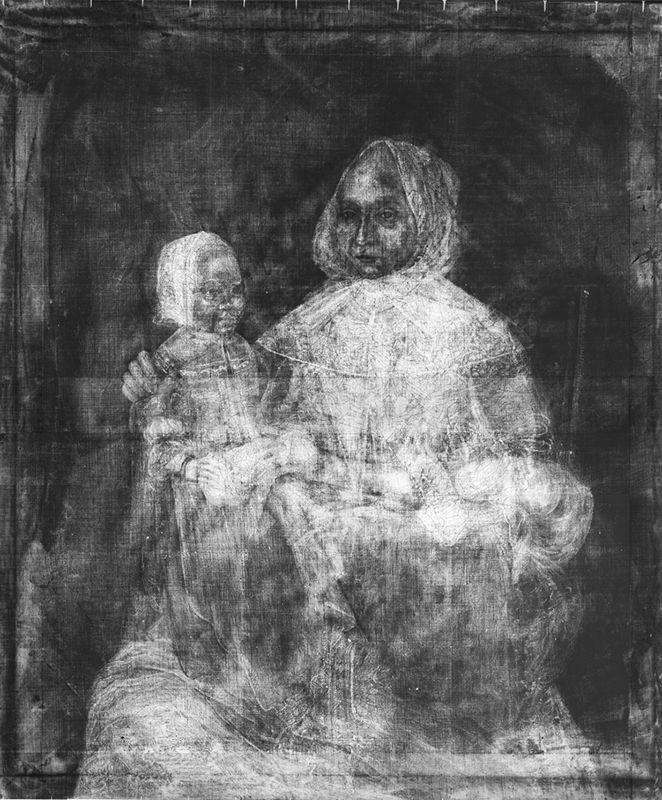
Indeed, in only one instance is the author of a seventeenth-century American portrait securely documented: we know that a woodcut portrait of the minister Richard Mather was made by John Foster, a member of the faculty at Harvard (Fig. 4). Only six copies of the print are known, but fortunately one of them was pasted into a book at Harvard and inscribed by Foster’s Harvard classmate, William Adams, who noted (in Latin) that the print represented “Ricardus Mather” and that “Johannes Foster sculpsit” – that is, “John Foster carved this.”5 The book containing the print is Increase Mather’s memorial tribute titled The Life and Death of that Reverenced Man of God, Mr. Richard Mather, which was published in the year of Richard Mather’s death, 1670. Most likely 1670 is the date of the woodcut as well.6
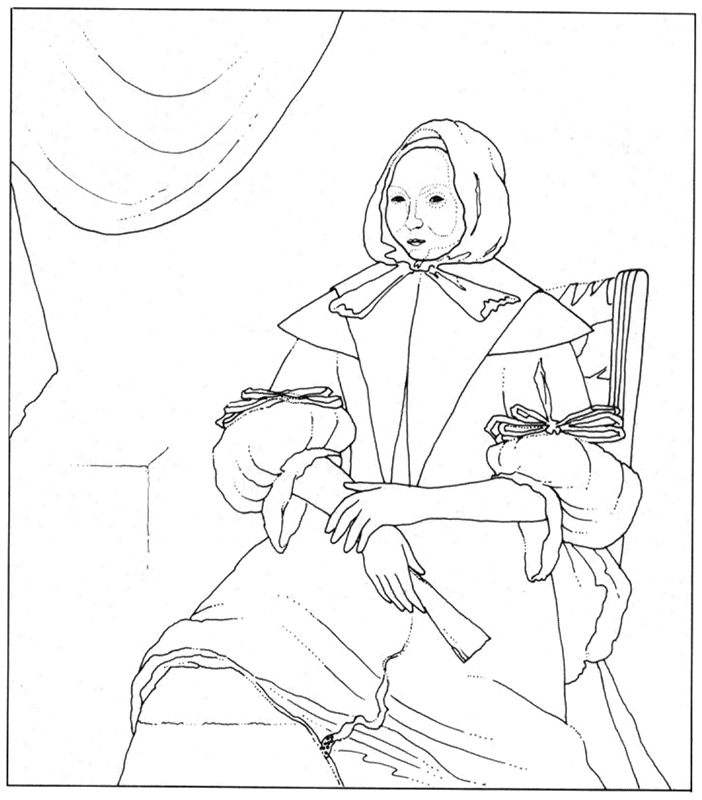
A multi-talented figure, Foster was a mathematician, astronomer, and printer, who published several almanacs, wrote a treatise on comets, and published the first American diagram of the Copernican system. In addition to producing this print of Richard Mather, most likely John Foster was also a painter. A poem about Foster by Thomas Tileston, titled “Funeral Elegy Dedicated to the Memory of… Mr. John Foster,” describes Foster as “a rare Apelles,” which seems to imply that he made paintings, for if the poet had intended to praise Foster’s skill in carving woodcuts, most likely he would have compared him to a sculptor.7
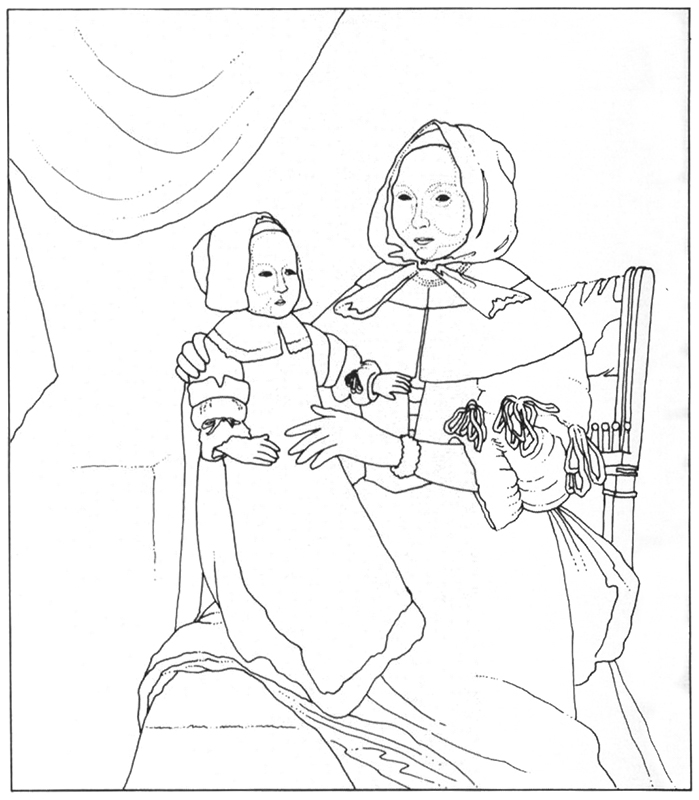
Two paintings have often been attributed to Foster. One is a portrait of Richard Mather, closely related to the woodcut, which sadly survives in such ruined condition that it provides little evidence for stylistic comparisons. The other is a portrait of the minister John Davenport (Fig. 5), executed in Boston in 1670, which now belongs to Yale University, and shows a costume, pose, and composition strikingly similar to the Mather print. X-rays reveal that both paintings are executed with a somewhat messy, rough, erratic technique, which lends support to the notion that they might have been executed by a talented amateur, like Foster, rather than a professional artist.8
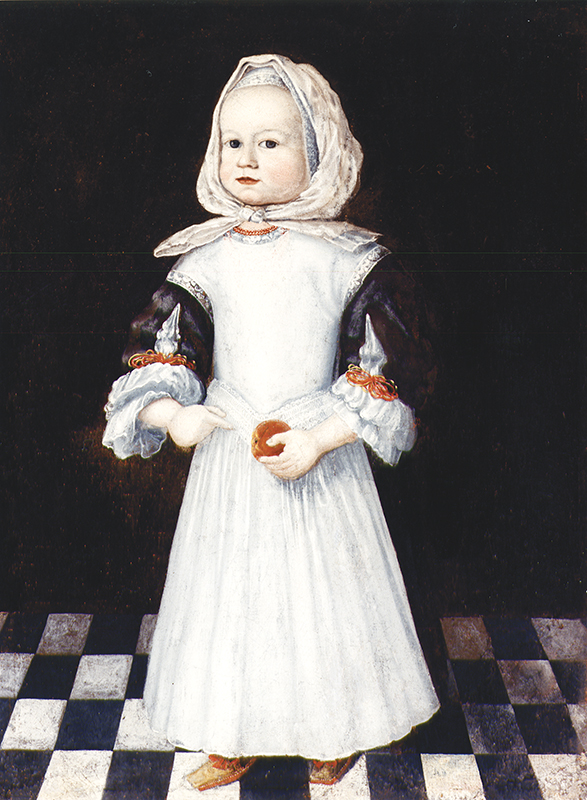
In short, solid facts about seventeenth-century American painting are rare. To form conclusions we must painstakingly piece together scattered tidbits of information, and we must draw conclusions, at least in part, from circumstantial evidence. Unfortunately, we have no such precise written statement establishing the maker of Mrs. Freake and Baby Mary. But by combining documentary records with visual evidence we can construct a strong case for its probable author.
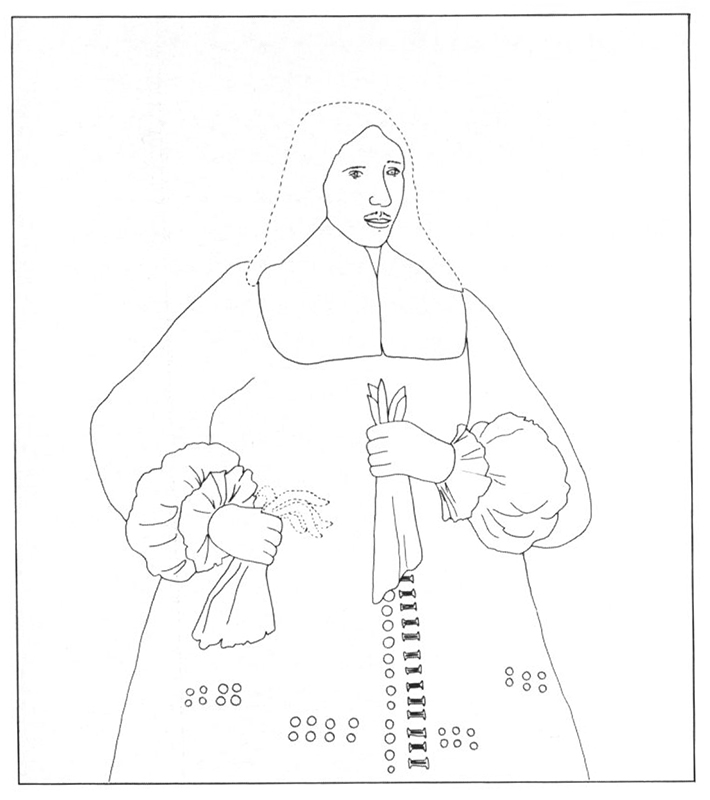
Mr. and Mrs. John Freake
While documents do not establish the authorship of the portrait of Mrs. Freake and Baby Mary, scholars have gathered a good deal of information about the sitter and her spouse, and this provides some hints about the character of the painter. For the Freakes were, by the standards of their time, extremely prosperous as well as upwardly mobile. They were interested in luxury and in obtaining the best goods and workmanship available in seventeenth century Boston. This fact helps narrow the search for the sort of painter they would patronize. It seems most likely that they looked for the most skilled artist available in Boston at the time.

Notably, the portrait of Mrs. Freake forms a pair with a likeness of her husband, Mr. John Freake (Fig. 9), which was most likely executed concurrently. Most textbooks show only the portrait of Mrs. Freake, but in fact the portrait of her husband, while not quite so colorful and decorative, is perhaps even more revealing in its expression of personality and likeness. Mr. Freake does not at all fit the stereotype of the grim and self-doubting New England puritan: he exudes charm. Dressed in his best clothes, and holding a glove in his hand, he seems thoroughly pleased with himself–and indeed, he had good reason to be, for Mr. Freake was an early specimen of a successful capitalist entrepreneur.
John Freake was born in England in 1631, in the manor house of Hinton St. Mary, Dorset County, the third child of Thomas (1598-1642) and Mary Dodington Freke (d. 1686), who were members of the local gentry. Since land in England was passed to the eldest son, younger sons often looked outside their region for opportunities. John Freake immigrated to Boston by 1658, and probably with the help of funds provided by his family, became a business associate of Captain Samuel Scarlett. He is listed in contemporary documents as a merchant and attorney, and served the town as constable and juryman. In 1661 he married Elizabeth Clarke, daughter of a merchant in Boston’s North End, who bore him eight children.
Coming, as he did, from an aristocratic background, Freake held somewhat different values than the Puritan ruling class. He seems to have been more Royalist in politics and apparently also more luxury-oriented in his private life. In 1666, for example, he supported recognition of King Charles’s commissioners in Boston—a challenge to the Puritan government of the colony. Perhaps in retaliation, a few years later the General Court denied a request filed by him and other merchants to license privateers during the Anglo-Dutch War (1672-1674). Nonetheless, when bark owned by Freake, the Philip, was seized near Mount Desert by a Dutch privateer, the colonial government launched a successful expedition to recover the ship.
Freake died in a gunpowder explosion on one of his ships, very likely caused by spontaneous combustion. He left no will, but an inventory of his estate, compiled on July 24, 1676, shortly after his death, show that he was a prosperous man, who owned an old and new dwelling house, a brewhouse, land at Fort Hill, and was a partial owner of six ships. At a time when many people did not own chairs at all but simply sat on the floor or on benches, he owned fourteen chairs with fancy “Turkie work” coverings — one of which is evidently represented in the portrait of his wife. The inventory also lists other items which appear in the two portraits. For example, it lists a brown coat, silver buttons, and a gold ring, all of which appear in Mr. Freake’s portrait, as well as forty yards of lemon-colored silk, which appears to have been used for baby Mary’s dress.9
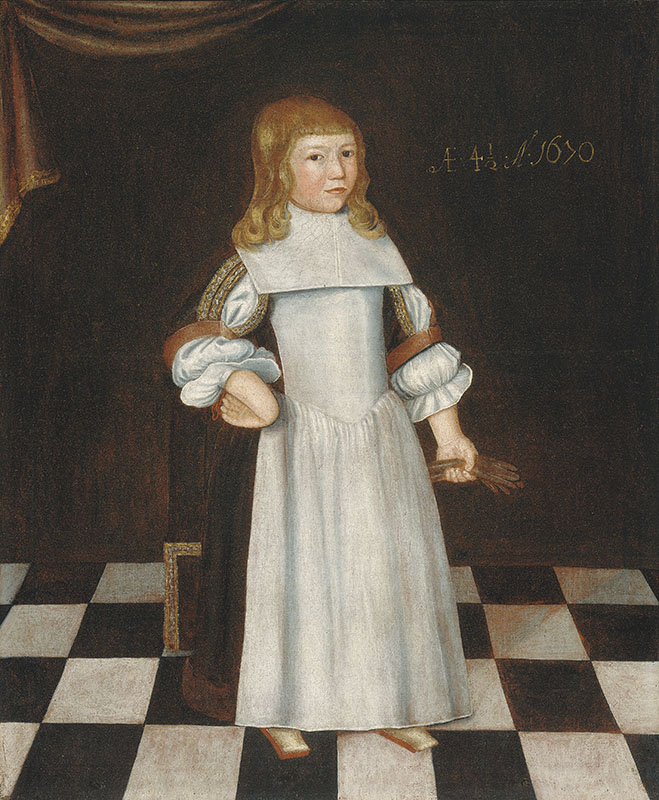
Mr. Freake’s wealth and interest in up-to-date fashions is indicated by his collection of silver, which was very extensive: one of the two most significant seventeenth-century listings of silver in the records of Suffolk County.10 What’s more this inventory lists an extraordinary novelty for the time — a set of six forks. Forks did not come into general use until fully a century later, so evidently Mr. Freake was at the cutting edge of new fashions. Indeed, based on the existing evidence, Mr. Freake may well have been the first American to use a fork.11 Sadly, Mr. Freake was not able to enjoy his forks and “Turkie work” chairs for very long. In 1676 he was killed, along with his business partner Captain Scarlett, on a gunpowder explosion on one of his ships, apparently set off by spontaneous combustion.12

Even if we didn’t know from his inventory that Mr. Freake owned fourteen chairs and six forks, we could guess from the portrait of his wife that he was prosperous, by noting the elaborate turnings on the spindle of the chair in which Mrs. Freake sits, as well as her elaborate clothes and jewelry. She wears a marvelous lace collar, colorful ribbons on her sleeves, a colorful red underskirt, has a triple row of pearls around her neck, and wears a ring on her finger —oddly enough on her thumb. To her left, virtually invisible in most reproductions, but not hard to make out if we examine the painting itself, is a child’s high chair—an item which was surely rare indeed in this period.13

Dating the painting of Mrs. Freake presents an interesting set of problems, for two different dates have been discovered on the piece. On the front of the painting the child’s age is provided in the Latin inscription “AETATIS SUAE;6 MOTH”(which literally translated into English as: “Her age: 6 months”) that appears just above the table. Family tradition identifies the child as Mary, who was born on May 6, 1674, the eighth and youngest child of the Freakes. This would indicate that the painting was painted in October 1674.
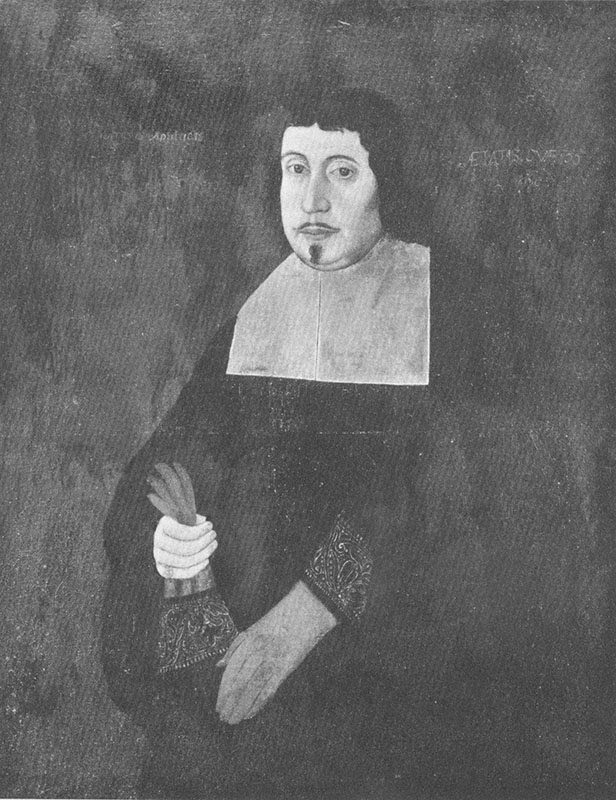
Recently, however, a second inscription was discovered on the back of the painting, which reads “Ano Dom 167[?] AE TATIS SUAE 29.” The last letter of the date is not legible, but since Elizabeth Freake was born in 1642, this would suggest that the likeness was painted in 1671, when she was twenty-nine years old.
Recently, also, x-rays were taken of the painting (Fig. 7), and they seem to solve this riddle, while also providing interesting insights into the intentions of the artist. They reveal that the original painting (probably executed in 1671) was very different from the one which is now visible (see the diagram, Fig. 8). Most strikingly, the baby was not part of the original design. Mrs. Freake once sat alone on the chair, with her hands crossed in her lap, with an object, probably a fan in her right hand. She had a black dress, trimmed with red ribbons, a differently shaped collar, which jutted out from her shoulders, and a double-pointed neckerchief extending down to her waist.

Several years later, probably in 1674, the painter went back to the canvas, and made adjustments to indicate the changes that had occurred over the space of a few years. The most significant of these was to add the baby. In addition, he changed the color of Mrs. Freake’s dress to gray green, made the collar fit her shoulders more closely, removed the neckerchief, added a lace bodice and slimmer sleeves, added more ribbons to her sleeves, and added a black beaded bracelet, pearl necklace and gold thumb ring.
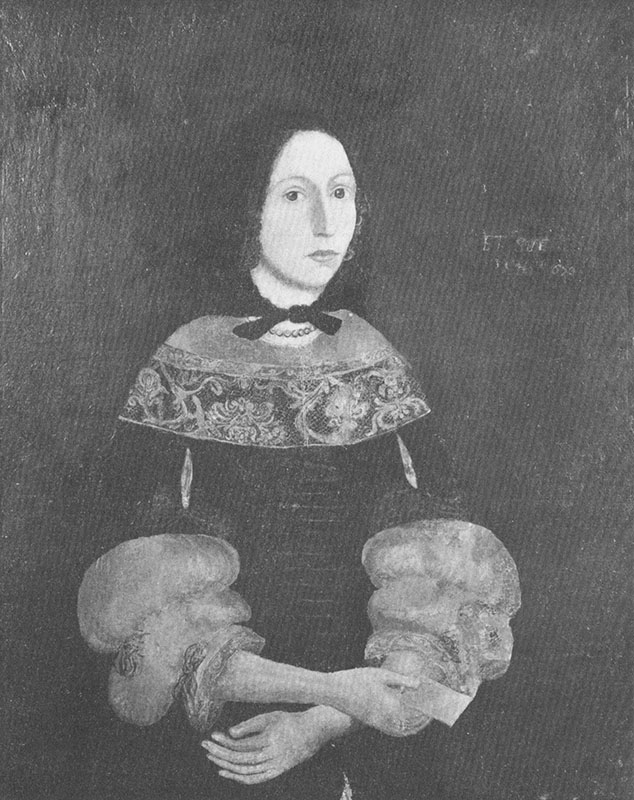
While it carries no date or inscriptions, x-rays reveal that the portrait of Mr. Freake (Fig. 9) went through exactly the same process of changes, probably concurrently with the portrait of his wife (Fig. 10). Originally (probably 1671), the artist showed Mr. Freake holding a glove in each hand. Later (probably 1674), he changed the position of the proper left hand, removing the glove (placing both gloves in the proper right hand), and showing Mr. Freake fingering a jeweled pendant hanging from his lace collar. To fill the space once occupied by the glove, he added nine more silver buttons and braided buttonholes, as well as a gold ring to Mr. Freake’s hand. In addition, since Mr. Freake had grown older and gained weight, the painter moved his hairline back and slightly broadened his face.
While these changes in the two Freake portraits are often subtle, as several scholars have pointed out, when taken together they form a consistent pattern. Overall they show a slightly more prosperous couple. Mrs. Freake has a more colorful dress and more jewelry, and Mr. Freake is plumper, has a costly new pendant, which he fingers, and can show off more of his silver buttons. In other words, the Freakes had moved up in the world and wanted their portraits to indicate their improved status.14
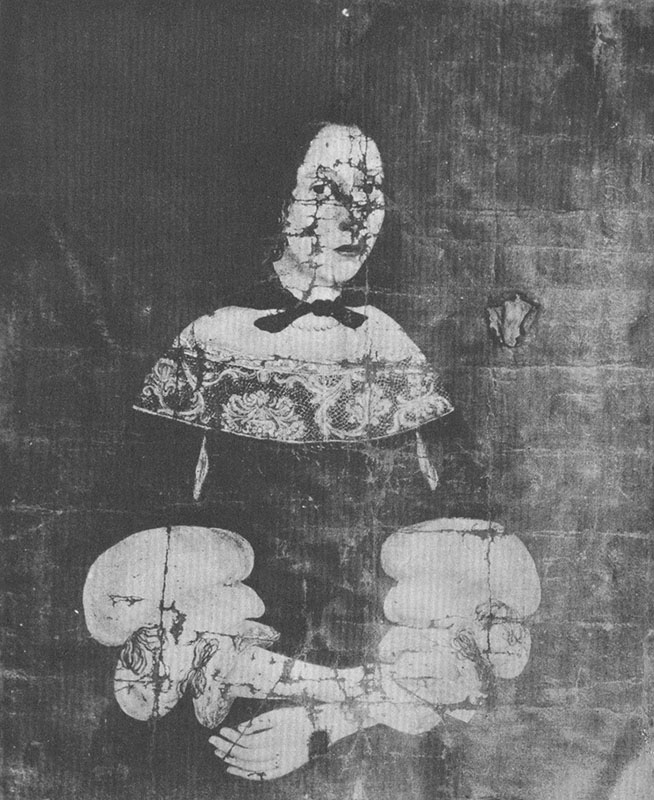
Other Works from the Freake Workshop
In the quest to identify the author of the Freake portraits, the first step is to recognize that they are very closely related to nine other seventeenth-century American paintings. Not all of these paintings seem to be by the same hand, but their similarities of materials, proportions, and general style, strongly suggest that have an artistic connection and most likely came from the same workshop.
The first of these is the earliest datable painting from New England, as well as the earliest likeness of an American doctor: a portrait of Dr. John Clark in the Boston Medical Library (Fig. 11). The portrait provides Clarks age (AETATIS SUAE) as 66, and since he was born in 1598, this establishes that the likeness was made in 1664. A careful recent technical examination also revealed a faint date of 1664 on the painting. Dr. Clark is shown seated at a table with his hand beside a skull. Since modern specialization was in its very early states in this period, doctors were a rarity in seventeenth-century communities and did not usually practice medicine full time. Dr. Clark, for example, served as a magistrate and deputy to the General Court of Massachusetts. But he also served as an apothecary, doctor, and most notably, as a surgeon widely known for his skill in removing gall bladder and kidney stones. Puritans were fond of skulls as a sign of earthly vanity, and it may well have carried such a meaning here, but it also clearly had another significance as well. Clark was the first physician in North America to trepan or cut into, the skull. Appropriately, therefore, he is shown with a trephine, a surgical crown saw, in his right hand, and a skull beside him.15
The surface of the painting has been much damaged and abraded, and to most modern eyes the portrait appears flat, primitive, dreary in its dark colors, and in general, not particularly attractive. But the artist’s use of cast shadows and reflected highlights in the face suggests an artist of professional skill–someone who was more than just an amateur. Scholars agree that the painting must have been made in America, both because Dr. Clarke was living in Boston at the time, and because the painting’s original black-painted frame is made of American red oak.16
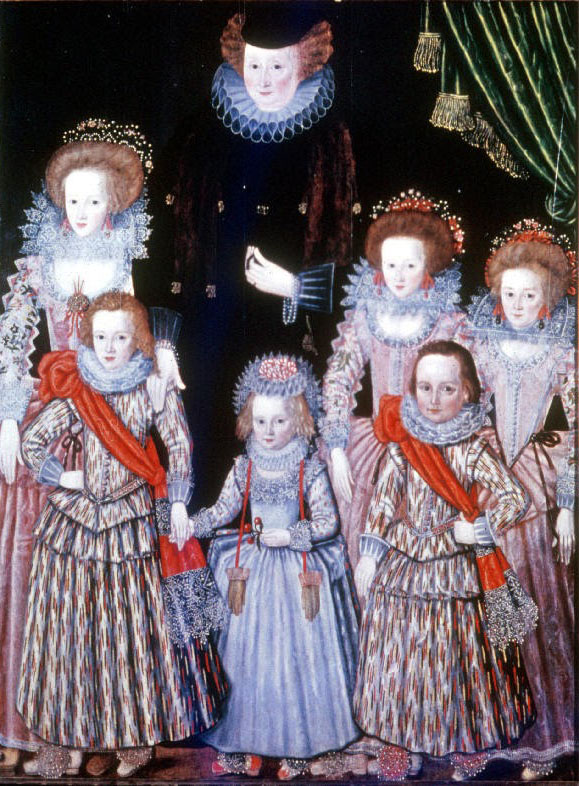
Nine other paintings from this same workshop were made about six years later. Two of these are the Freak portraits, which as noted, were probably painted in 1671 and reworked around 1674. The others all date from around 1670, although in one instance (Edward Rawson) the last digit of the date is not clearly legible. Because of their proximity of date, these paintings are sometimes known as “The Group of 1670.”17 They are as follows:
- David, Joanna and Abigail Mason (Fine Arts Museums of San Francisco), dated 1670.
- Alice Mason (Adams National Historic Site, Quincy, MA), dated 1670.
- Robert Gibbs (Museum of Fine Arts, Boston), dated 1670.
- Margaret Gibbs (Museum of Fine Arts, Boston), dated 1670.
- Henry Gibbs (Avampoto Museum, Charleston, West Virginia), dated 1670.
- Edward Rawson (New England Historic Genealogical Society), dated 1670.
- Rebecca Rawson (New England Historic Genealogical Society), dated 1670.
As scholars have long noted, all these paintings are relatively flat in their handling of space. As Louisa Dresser wrote of the author of Mrs. Freake and Baby Mary:
He had no idea of having his figures exist in space. In his portrait of Mrs. Freake and Baby Mary a chair is shown and it may be assumed that Mrs. Freake is seated on it but her knees seem no nearer the spectator than the rest of her body and the baby on her lap has no more volume than a paper doll. In fact, both figures might have been cut out of paper, so distinct are their outlines against the dark background…18
There is some exaggeration to this statement (as well be discussed below), but scholars now agree that in style these paintings are essentially Elizabethan, even medieval, and that they preserve a kind of painting that was already out of date, dying out, and largely superseded in England. Not so long ago it was fashionable to claim that these effects of flatness were uniquely American. John McCoubrey, for example, in a book on American Tradition in Painting argued that the flatness and spatial irresolution of the Freake portrait derived from living on the American frontier. He read into it qualities of anxiety and rootlessness.19 It’s probably a mistake, however, to seek for some mystic essence of the American sensibility in these effects. In fact, we find similar, and indeed, even more startling effects of flatness in Elizabethan portraits, such as the a striking portrait of circa 1600-1610, traditionally known as The Cholmondeley Ladies (Fig. 22), by an anonymous English artist, which is said to represent two sisters who were born on the same day and married on the same day.20 If we had to rank which of the two paintings is the stranger in its rendering of space, the Chomondely sisters would surely come out ahead.
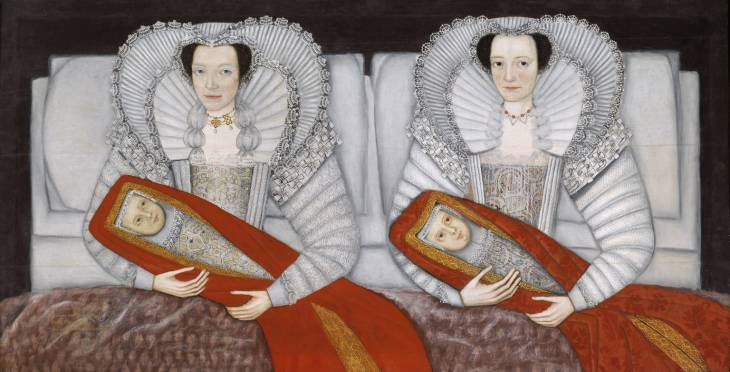
This flatness of effect provides an interesting example of the slowness of cultural communication in this period. England lies some distance from Florence, Italy, where Renaissance perspective and illusionistic painting was developed. As a consequence, medieval habits of representation lasted longer. English portraits of the Elizabethan period show some degree of Renaissance modeling, but have a flatness of overall effect which continued medieval traditions. In fact, the English seem to have actively resisted the Renaissance tradition. The famous Swiss painter Hans Holbein, for example, who painted portraits for the court of King Henry VIII, adopted a flatter style after he had lived in England for a few years, and began using flat background covered with lettering rather than setting his figures in an illusionistic space.21
By the 1650s, at least in up-to-date placed like London, English painting had grown more sophisticated, due to the influence of figures such as Anthony Van Dyke (who settled in England in 1632), and had developed a better sense of spatial depth and modeling. But as late as 1670 these advances hadn’t made their way to Boston, Massachusetts. As a consequence, the portrait of Mrs. Freake represents a type of painting similar to what had been fashionable in England many years before. In a city like London this style was some fifty years out of date, although it was still sometimes practiced by artists who lived outside the major centers.
With the exception of the Rawsons, all these figures, like the Freakes, were exceptionally wealthy, suggesting that the artist was someone of special skill—at least for the place and period. While closely related in style, these paintings all have interesting individual qualities, no doubt in response to the particular circumstances of each commission. The triple portrait of the Mason children (Fig. 12) is the only early New England portrait to include more than two figures in the composition. This sort of family portrait, however, was common in Elizabethan England, appearing, for example, in a portrait of Lady Sidney and her family in the collection of the Earl of Dudley (Fig. 21). Interestingly, in the American version of this formula, the parents are not shown. The eldest son, David, appears at the left, with gloves in his left hand and a silver-headed walking stick in his left which seems to indicate his status as a male heir. His two sisters appear to his right, with the elder of the two closest to him.
The portraits of the Gibbs children are similar in concept, although the children were not squeezed together on one canvas, but portrayed separately. Presumably, Robert, the eldest (Fig. 14), was placed at the far left, facing his younger siblings, Margaret and Henry (Figs. 15 and 16). Robert holds leather gloves, perhaps to indicate his status as the eldest. Poised on Henry’s finger is a cardinal—it is not clear whether the artist intended a real bird or a carved likeness. This may have been intended as a symbol of the Christian soul, and by extension, of childhood innocence. Around Henry’s neck is a string of coral beads, thought in the seventeenth-century to protect against disease.22
Interestingly, the father of these children, Henry Gibbs, was not only a wealthy man but one who (somewhat like John Freake) defied the usual stereotypes of the Boston Puritan since he was both an aristocrat and a royalist. The fourth son of Sir Henry Gibbs, a knight from Homington, county Warwick (near Shakespeare’s hometown of Stratford-on-Avon), Henry Gibbs emigrated to the United States due to his status as a younger son, and his father’s difficulties as a supporter of Charles the First. Shortly after his arrival, he married a very wealthy local woman, Elizabeth Sheafe, and went into business as a merchant. Apparently with money inherited from his wife’s father, Gibbs built a mansion house in the East part of Boston which John Josselyn, the author of New England Rarities Discovered (1662) described as “a stately Edifice, which it is thought will stand him in little less than 3000 £. before it be fully finished.” The portraits of the three Gibbs children were evidently intended for the hall (or best room) of this mansion.23
Somewhat different in concept are the portraits of Edward Rawson and his daughter Rebecca, which are more subdued in effect. That of Rawson (Fig. 17) shows him soberly dressed in black, with a white ruff, placed against a plain background. That of his daughter Rebecca (Fig. 19) shows fancier lace, but is similarly restrained. Rawson served in many prominent positions in the colonial government, first as town selectman and public notary in the town of Newbury, and later as secretary of the Massachusetts Bay Colony and recorder for Suffolk County. But his devotion to public service gave him little time to devote to his own business, and at the time of his death in February 1694 he was nearly destitute, with an estate valued at a meager 51 pounds. Rebecca also suffered serious reversals. In 1679 she made an unfortunate marriage to Thomas Rumsey and accompanied him to England, where he deserted her. She lived in England for thirteen years, and then moved to Port Royal, Jamaica by 1692, where she was living in poverty when she was killed by a tidal wave in 1692.24
Early scholars attributed nearly every one of these paintings to a different master, since there are some differences between them. Some figures are set against a featureless background while others stand on a tiled floor. Some paintings are painted a little more delicately than some of the others. Early textbooks on American art speak of the Freake Limner, the Gibbs Limner, the Mason Limner, and so forth.25 But this seems like a lot of limners to be producing very similar portraits in the same year in a city of not more than 1,500 families.26 In fact, all these paintings are so close in date, and so similar in handling that it seems likely that they were executed in the same workshop, if not by the same hand. For example, they all use precisely the same canon of proportions to render the figure, and chemical tests have shown that they all were executed with virtually the same pigments.
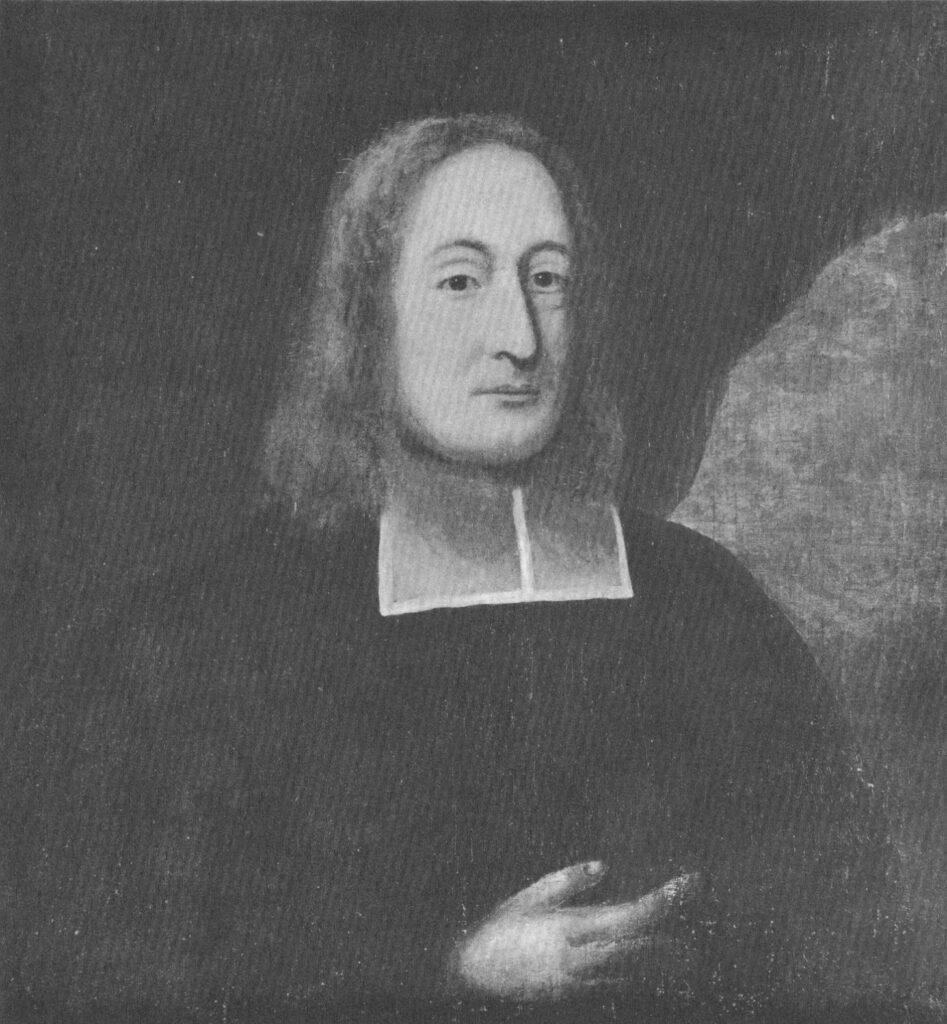
As was noted in the statement by Louisa Dresser, cited earlier, the general effect of these paintings is quite flat. But for all that, the artist of these works was not completely ignorant of Renaissance illusionism, and in fact Louisa Dresser’s statement about their flatness needs to be somewhat modified. Can we call this style medieval? Not quite.
I have mentioned that there is shading in the portraits of Mr. and Mrs. Freake (as well as in all the other portraits of this series), although it is applied very delicately, so as not to blur the outlines or muddy the clarity of the forms. Interestingly, in fact, modeling is most evident in small details, such as the buttons, which are rendered with a clear contrast of light and shade. In the larger forms, the shading is more subdued.
What is more, the painter of these works was at least somewhat cognizant of Renaissance perspective. Thus, while the painting of Mrs. Freake contains no clues about the recession of objects in space, the Gibbs and Mason children are shown standing on tile floors, and if we trace the recessive lines of these tiles towards a vanishing point, we find that they approximately meet. To be sure, the artist made some mistakes (Figs. 23 and 24). For example, while the lines of recession come close to meeting, they do not quite join at a single point; and in addition, the width of the tiles is not exactly even, as it would be in real life. But clearly the painter of these portraits had some knowledge of perspective, quite probably gained from reading books (Fig. 25).
He did not grasp all the complexities of the theory, and he tried to combine the new ideas from his reading with the traditional manner of painting in which he had been trained. For all that, these painting reveal the dim beginnings of a new vision of the world—a world which would no longer be flat, but would recede into depth, through the mastery of perspective and light and shade. In short, as with the furniture of the period, these works, while generally medieval in appearance, contain interesting hints and foreshadowing of an underlying change which would soon lead to radical transformations.27
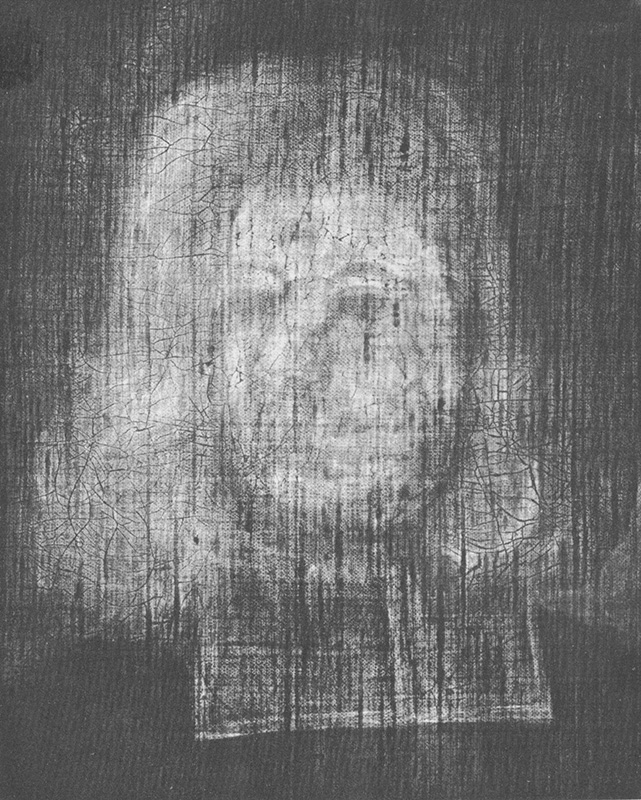
The problem of attaching stylistic labels to this sort of painting is similar to that encountered with seventeenth-century American furniture. Since some seventeenth-century American furniture contains Mannerist details, it has sometimes been described as Mannerist in style. Other writers, however, have noted that the basic forms are not so much mannerist as Renaissance or even Medieval in character. Perhaps the best term for both seventeenth-century furniture and painting would be “Modified Medieval,” to suggest the way in which provincial, medieval approaches were modified by later influences from different regions and periods, including some which were thoroughly up-to-date.28

It seems plausible to suppose that the paintings of Mr. and Mrs. Freake and the paintings of “The Group of 1670” are all by the same artist. But the question of to what degree the somewhat earlier portrait of Dr. Clark relates to these nine paintings has been answered in different ways. Some writers, such as Sidney Gold (although his wording is somewhat vague), have suggested that all these paintings might be by the same individual. Others, such as Joy Cattanach, have noted that the handling of detail is quite different, and that x-rays bring out a different quality of brushwork. They’ve implied that it’s rash to see any connection at all between these works.
Accurate judgment is hampered somewhat by the fact that the portrait of Dr. Clark is in poor condition, but my own feeling falls between these two extremes. The materials and general proportion of the figures are very similar. If we compare areas that are roughly comparable—let’s say compare the head and shoulders of Dr. Clark with the head and shoulders of David Mason, the eldest son and largest figure in The Mason Children, who wears a similar white collar to that of the doctor—the general handling of form, that is, the way that head, collar and body relate to each other, is strikingly similar. We’re dealing with paintings that fall into the same “family”—that are closer to each other than they are to any other paintings of the “first settlement” period that have come down to us. Nonetheless, significant differences are evident. The paint handling of Dr. Clark—even allowing for the issue of damage and restoration—is rougher and cruder. What’s more, the painting itself shows none of the love of detail and finery of lace and costume of the other paintings—something that could partly be attributed to the technical finesse of the painter, and also, perhaps, to the fact that the Freake paintings, and those of “The Group of 1670,” are as much as ten years later than the portrait of Dr. Clark, and seem to reflect a slightly different cultural sensibility, less concerned with the virtue and sobriety of the first settlers, more with the prosperity of the social leaders of a rapidly growing community. In other words, as already hinted, it seems possible that these paintings belong to the same “family” but were not created by the same hand.
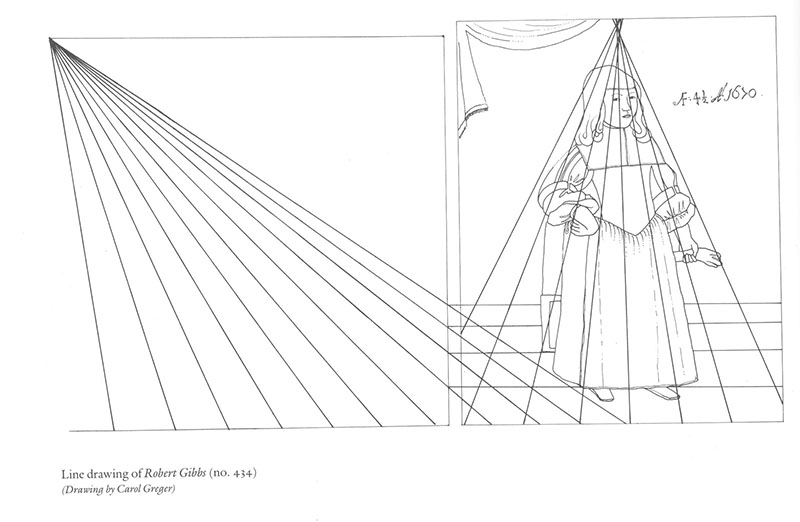
The Authorship of These Paintings
Who was the author of these various works? To move towards an answer to this question we must turn to documents. With very few exceptions, the only documentary references to painters are in probate records, where this term is sometimes found. In most instances, the figures listed as “painters” in seventeenth-century documents were probably essentially house-painters. Admittedly, house-painting in that period often went beyond simply employing flat tints, and included decorative talents. Very often, for example, painters were trained to create sponged and spotted designs which were similar in effect to modern wallpaper, although of course less mechanically exact. Moving up the ladder of skill, painters were sometimes skilled in making signs, and in producing paraphernalia, such as banners and death’s heads, for pageants and funeral processions, which were often quite elaborate and occupied an important place in the social ritual of the period. But there is only one painter described in seventeenth-century documents in a fashion which makes clear that he was more than a decorator and was trained to do figurative work: Augustine Clement.29
Clement was born in England, probably around 1600. In his youth he was apprenticed for eight years to a decorative painter, Jonathan Miller, of Reading, England, and afterwards served four more years of apprenticeship with Edward Newman of Eton. After completing his term, Clement returned to Reading, where he worked as decorative and heraldic painter, and engaged in a lawsuit to prevent an interloper in town, James Semour, from making “drawings” and “drawn works.” In 1635 Clement left England for America, settling in Dorchester, where he is listed in various documents both as a painter and painter-stainer.
Clement is the only seventeenth-century Boston painter who is described in documents in a way that makes it clear that he was not simply a house painter but was trained through a system of apprenticeship to do figure and portrait work. From the documentary evidence, his training was at a level above any other painter in New England. In addition, documents directly link Augustine Clement with the Dr. John Clark, the subject of the earliest of the paintings from the Freake workshop. On the 20th of March 1652 Clement bought land in Boston (he is described as a “painter” in the deed), and the documents stated that Clement’s land was bounded on the north by the house and land of John Clarke.30 Given that Augustus Clements was a skilled painter (in fact, the only fully trained painter in Boston) and that he lived next door to John Clarke it seems likely that he was the painter of the John Clarke portrait–and thus the earliest known painter to practice his livelihood in this country.31
What about the portrait of Mrs. Freake, as well as the other portraits from around 1670?
It is tempting to attribute them to Augustine Clements, as has sometimes been done in the past, but unfortunately there are two problems. First, Augustus died on October 1, 1674, the very month in which the portrait of Mrs. Freake was repainted. If Augustus was an old man on his deathbed it seems unlikely that he could have been busy repainting the portraits of Mr. and Mrs. Freake. Moreover, as has already been indicated, the Freake portraits, and most of the other paintings of this group seem to be more skillfully painted than the portrait of Dr. Clark, the painting most convincingly ascribed to Augustine Clement, and their brushwork seems more refined and delicate. Yet they also possess striking affinities with the Clark portrait, in their handling of form and in their materials.
How can we explain this? Fortunately, there is a simple solution to this problem. Augustine had a son Samuel who was also a painter, according to the testimony of contemporary documents. In an indenture for a land sale, drawn on June 21, 1695, shortly after his death, he is described as “Painter Stainer”; and an inventory of his estate taken on December 25, 1678 mentions that his “dwelling House in Boston, with Wharfe and Warehouse” contained “colouring Stuffe for painting” valued at 5 pounds.32 This is apparently the only instance in seventeenth century New England in which a father and son are both identified in documents as painters.
We can go on to conjecture that the paintings of this group, as has already been hinted, might well have been the product of a family workshop. Since Samuel surely learned his trade from his father, it’s not surprising that all the paintings of the group show a similar canon of proportion and similar materials. But differences within the group are apparent suggesting that two hands were at work. The execution of Mrs. Freake and Baby Mary, for example, is more refined than that of the portrait of Dr. John Clarke. The brushwork is finer, the execution feels superior, and there is more attention to intricate details such as lace and ribbons. What’s more, the paintings of the Gibbs and Mason children show a somewhat tentative effort to move away from late medieval techniques and to master the principles of Renaissance perspective, which isn’t evident in the Clarke portrait.
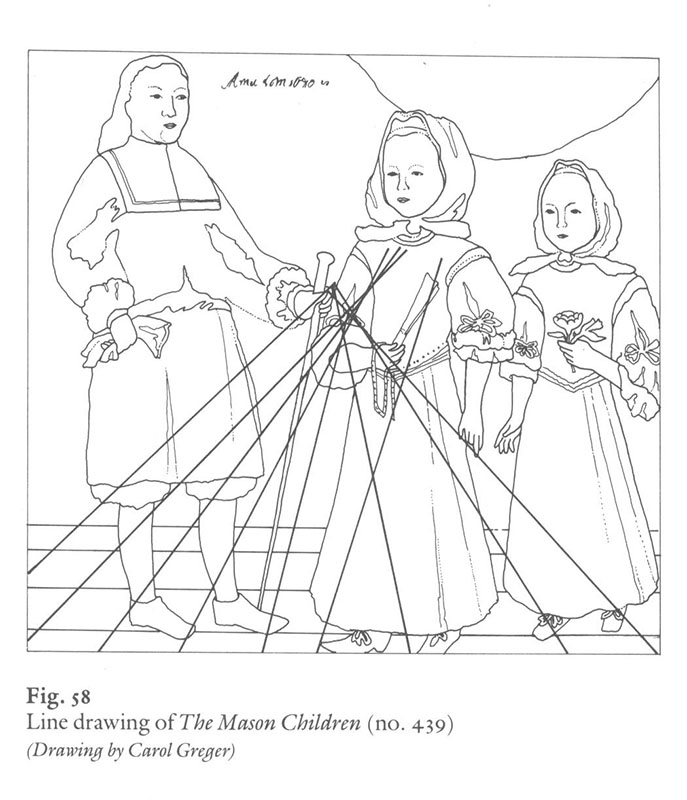
What seems likely, in fact, is that the Clarke portrait is by Augustine Clement, and the other portraits of the members of the Freake, Gibbs and Mason families are by his son Samuel. Samuel lived just four years longer than his father, dying in 1678, but this provides enough of a window for him to have repainted the Freakes in 1674. Moreover, his early death would explain why the paintings of this type were only produced for a short period. We have no works from the “Freake workshop” that are dated later than 1674.33
The conclusion I’ve proposed seems simple, once all the evidence is laid out, but to my knowledge, while scholars have danced around this question for more than half a century, they have never systematically grouped together the works of the Freake Limner; shown the ways in which this painter’s work relates to the portrait of Dr. Clark; or clearly shown which painting (that of Dr. Clark) might be by Augustine—and which paintings (the works associated with the Freake Limner) could not be by Augustine but might, very likely, be by Samuel. It should be confessed that attributing these portraits to the two members of the Clement family rests on circumstantial evidence rather than on firm documentary proof. But it seems to me that recent writers on this question have often needlessly complicated the issues: whether by exaggerating the stylistic differences between one painting and another (which would suggest that we need to look for several artists, rather than just for one or two); or by proposing that every house painter in Boston was a possible author of these works (when in fact they were clearly the work of painters who were well trained, albeit in a somewhat archaic mode of work, and a typical house painter could not have executed them). At its heart the conclusions I’ve proposed rest on a rather simple assumption: that the only painters in Boston who are known through documents to have been trained to do portrait work may well have been the authors of the principal group of Elizabethan-style portraits produced in the city.
Certainly it’s striking that their presence coincide with this sort of work and that it disappears around the time of their death. Up through the 1670s, the Clement, father and son, were, so far as we have any documentary record, the best-trained portrait painters in Boston. If my hypothesis is correct, they seem to have attracted the patronage of the wealthiest people in town. With the exception of the Rawsons, all the surviving paintings attributed to them, portray figures of social prominence and substantial financial means, and they seem to have had no serious rival or rivals. By the mid 1670s, however, a date which roughly coincides with the deaths of Augustus and Samuel Clement, works in this Elizabethan or late medieval style disappear in Boston. The next major portrait painter whose oeuvre can be identified, Thomas Smith, whose earliest paintings date from the late 1670s, worked in a distinctly different manner, a provincial version of the Baroque style.34
Providing this identification helps us understand and localize the artistic tradition that all these portraits represent. As has often been noted, the Puritans who settled seventeenth century New England often named towns for the places they had come from in England and often carried on craft and workshop and house-building traditions that reflected the places they had come from—often the customs of particular villages. While sometimes portrayed as uniquely American artifacts, in actual fact the paintings of the Freake Limner—here tentatively identified as Augustine Clement’s son Samuel—directly carried on workshop traditions that were transported from England. What he (and his father) accomplished in painting, in short, was culturally completely in tune with the working practices of the New England house-wrights and furniture makers of the “first settlement” period.
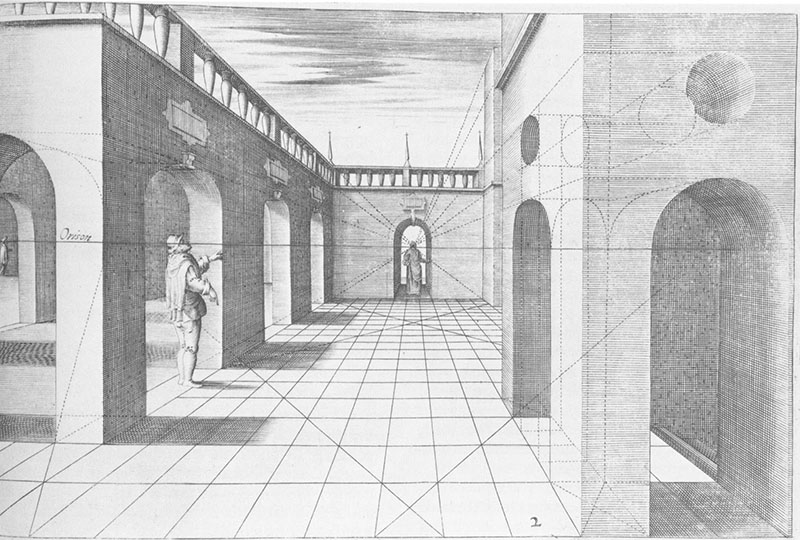
HENRY ADAMS, the Ruth Coulter Heede Professor of Art History at Case Western Reserve University, is the author of more than four hundred articles and several books in the fields of American art and design. He is currently at work on a biography of John La Farge.
1Louisa Dresser, “The Freake Portraits,” Worcester Art Museum News Bulletin and Calendar, vol. 29, no. 5, February 1964, n.p. The most up-to-date source of information on the painting is provided in a the remarkably thorough and informative online catalogue of Early American Paintings in the Worcester Art Museum spearhead by David Brigham, Curator of American Art at the Worcester Art Museum. This lists 93 books or journals in which the painting has been published. First published in 1881, the painting first entered the general literature on American art in Virgil Barker’s survey of American art of 1934, and has appeared in virtually every major survey since that time. 2While I have consulted other sources, much of the basic data available on seventeenth century American painting can be found in just two places, although neither of these sources fully synthesizes this information into a unified account. The most usable study of the subject, and still the only comprehensive book on seventeenth century American painting, is Louisa Dresser, XVIIth Century Painting in New England, a Catalogue of an Exhibition Held at the Worcester Art Museum in Collaboration with the American Antiquarian Society, July and August 1934, with a laboratory report by Alan Burroughs, Worcester Art Museum, Worcester, Massachusetts, 1935. The subsequent half century of scholarship has been gathered by Jonathan L. Fairbanks, Curator, and Robert F. Trent, Research Associate in New England Begins: The Seventeenth Century, 3 volumes, Museum of Fine Arts, Boston, 1982. A comprehensive overview of seventeenth century New England culture, with a “material culture” approach that values tools and artifacts as much as works of art, this analyzes objects of widely varying types. The way in which the entries on portraits are scattered through several volumes makes this compendium somewhat difficult to use. But it gathers much information not available in Dresser’s study, based on the subsequent half century of scholarship. It includes an essay by Jonathan Fairbanks on seventeenth-century American paintings as well as useful entries, mostly by Joy Cattanach, on many of the most important seventeenth century American paintings. 3Dresser, 1935, p. 17. 4Dresser, 1935, pp. 100-103. 5Adams also at one point employed Foster as a printer. 6See the entry on the print by Joyce Cattanach in Fairbanks, 1982, vol. 2, page 132. 7See Fairbanks, 1982, vol. 2, entry by Wendy Kaplan, pp. 147-48, and by Robert B. St. George, pp. 318-19. The poem by Tileston is cited and discussed by Dresser, 1935, pp. 68-69. 8This painting is discussed and attributed to Foster by Dresser, 1935, pp. 19 and 66-69. See also Joy Cattanach in Fairbanks, vol. 2, page 133, who notes that the brushwork and drawing on the Davenport painting dissociate it from other works of the 1670s such a the Gibbs and Mason portraits, and that it may be by the same artist that painted the damage painting of Richard Mather in the American Antiquarian Society, as well as portraits of John Cotton (Connecticut Historial Society) and John Wheelwright (Massachusetts State House). 9See the entry on the portrait of John Feake by Joy Cattanach, in Fairbanks, 1982, pp. 461-62 citing information drawn from Suffolk County Probate Records. 10The other was that of the Reverend Dr. Leonard Hoar. See Albert S. Roe and Robert F. Trent, “Robert Sanderson and the founding of the Boston Silversmiths’ Trade,” in Fairbanks, 1982, vol. 3, p. 481. 11See Albert S. Roe and Robert F. Trent, op. cit, in Fairbanks, 1982, p. 483, who describe Freake’s taste and silver as “avant-garde” and note: “The eight forks listed in Freake’s inventory are an extremely early reference to the form, which did not come into general use for individual dining until well into the eighteenth century.” 12The explosion is recorded in the journal of the Reverend Simon Bradstreet, the husband of the first American woman poet, Anne Bradstreet. Bradstreet noted: “Mr. Freak & Capt. Scarlett of Boston were killed by ye blowing up the desk of a ship by ye Carelessnes of some aboard. There were diverse others that were very dangerously wounded and some of yem after dyed.” See Simon Bradstreet, “Bradstreet’s Journal 1664-1683,” in New England Historic Genealogical Register, vol. 9, January 1855, pp. 43-51, citation from p. 47; see also the entry on the portrait of John Freake by Joy Cattanach in Fairbanks, 1982, p. 461-62. Since spontaneous combustion was only first identified by J. P. F. Duhamel in 1757, it is not surprising that Bradstreet attributed the accident to “carelessness,” though spontaneous combustion was surely the actual cause. 13The online catalogue of the Worcester Art Museum identifies this piece of furniture as a “table,” but in my opinion it’s clearly a child’s high chair from which the baby Mary has presumably just been lifted. 14For the changes to the Freake portraits, and the evidence that they were first painted in 1671 and revised in 1674, see Susan E. Strickler, “Recent Findings on the Freake Portraits, Worcester Art Museum Journal, vol. 5, 1981-82, pp. 48-55. This material has also been discussed in John Michael Vlach, Plain Painters: Making Sense of American Folk Art, Smithsonian Institution Press, Washington and London, 1988, chapter four, pages 87-103, particularly pages 96-99. Joy Cattanach has proposed that all the changes to Mr. Freake’s portrait were made at the same time, but I find it more logical to suppose that his painting was reworked at the same time as that of his wife, as Strickler has proposed. 15See the entry on the painting by Joy Cattanach in Fairbanks, 1982, vol. 2, pp, 338-340. 16Jonathan Fairbanks, in Fairbanks, 1982, vol. 3, p. 416. 17For “The Group of 1670” see Fairbanks, Portrait Painting in Seventeenth-Century Boston: Its History, Methods, and Materials,” in Fairbanks, 1982, vol. 3, pp. 417-18, who identifies these works as closely-related group. While somewhat ambivalent about whether they represent the work of one or more artists, he eventually concludes that “similarities between these paintings so far outweigh their differences that it seems unreasonable to arbitrarily assign them to separate hands.” Further on in the same catalogue, in an entry on The Mason Children, Joy Cattanach tentatively proposes that “the same artist” may have painted the Freake, Mason and Gibbs portraits, and notes that the portrait of Edward Rawsonis “important… because of its relationship to the Freake-Gibbs paintings.” See Cattanach in Fairbanks, 1982, p. 463. Louisa Dresser, 1935, pp. 20-21, introduced the notion of the “Group of 1670<” but included a few works which seem to be by a different hand than the rest, such as the portrait of John Davenport at Yale, which can be plausibly attributed to John Foster. 18Louisa Dresser, 1935, p. 23. 19John McCoubrey, American Tradition in Painting, University of Pennsylvania Press, Philadelphia, 1963, 2000, pp. 1-5 and 6. 20The story that the two ladies were born on the same day and married on the same day was first recorded in 1882, but in fact, the identity of the two ladies portrayed remains uncertain, as does the name of the artist. Since the eye colors of the two ladies are different, they are not identical twins. See John T. Hopkins, “Such a Twin Likeness there was in the Pair”: An Investigation into the Painting of the Cholmondeley Sisters,” Transactions of the Historical Society and Lancashire, vol 141, 1991, pp. 1-37, reproduced opposite p. 1. 21For a discussion of the flat, decorative, iconic, and neo-medieval qualities of Elizabethan English painting see Roy Strong, The English Icon: Elizabethan & Jacobean Porteraiture, Studies in British Art, The Paul Mellon Foundation for British Art, Loudon Routledge and Kegan Paul Limited, London, and Yale University Press, New Haven, 1969, for example, pages 3, 13-15. See also Samuel M .Green, “English Origins of Seventeenth-Century Painting in New England,” in Ian M. G. Quimby, American Painting to 1776: a Reappraisal, The Henry Francis du Pont Winterthur Museum, Winterthur, Delaware, The University Press of Virginia, Charlottesville, 1971, pp. 15-69. 22In addition to the published literature on these paintings, Virginia Point of Charleston, West Virginia has written a helpful typescript on “The Portraits of the Gibbs Children and Other Boston Portraits from the 1670s,”a copy of which is in the files of the Avampato Museum in Charleston, West Virginia. 23New England Begins, vol. 3, page 458. 24Dresser, 1935, p. 127. See also the entry on this painting by Joy Cattanach in Fairbanks, 1982, vol. 3, pp. 463-64. 25They also sometimes combined these terms to produce the Freake-Gibbs Limner, the Freake-Davenport Limner, the Freake-Mason-Gibbs Limner, and so forth. Increasingly there seems to be a consensus that the portrait of John Davenport is by a different hand than the rest. As has already been suggested, it may well be by John Foster. The other paintings can plausibly be attributed to the same artist—most commonly known today as “The Freake Limner.” 26Abbott Lowell Cummings, The Framed House of Massachusetts Bay 1625-75, Cambridge, 1979, p. 39. 27For a discussion of perspective in these works see Jonathan Fairbanks, “portrait Painting in Seventeenth-Century Boston: Its History, Methods, and Materials,” in Fairbanks, 1982, pp. 443-446. 28Jonathan Fairbanks and Robert Trent argue repeatedly in their contributions to New England Begins that New England artifacts should be viewed as “Mannerist” in style. This has been disputed by Joseph Manca in his article “A Matter of Style: The Question of Mannerism in Seventeenth-Century American Furniture,” Winterthur Portfolio, vol. 38, No. 1, Spring 2003, pp. 1-36, who argues that first-period American furniture is “best described” as “Renaissance.” In my view, the best term for the arts of this period is different still since the cultural roots of the Puritans lay in late-medieval England. In my view the best term for their aesthetic is “Modified Medieval.” In other words, they showed a preference for essentially medieval forms, but modified them with Renaissance and Mannerist elements. As is typical of new influences, Renaissance and Mannerist elements were generally first apparent in decorative elements and later modified the form itself. 29See Sidney M. Gold, “A Study in Early Boston Portrait Attributions: Augustine Clement, Painter-Stainer of Reading, Berkshire, and Massachusetts Bay,” Old Time New England, Bulletin of the Society for the Preservation of New England Antiquities, vol. LVIII, No. 3, January-March 1968, serial no. 211, pages 61-76. While brief, Gold’s article was the product of thirty-three years of research by four scholars. Sidney M. Gold, an antiquarian in Reading, Berkshire, published a notice in country Life, September 8, 1935, asking if any American correspondents could furnish him with information concerning the Reading painter, Augustine Clement, who had sailed for New England in 1635 as part of the Great Migration. By this means he got in touch with Nina Fletcher Little and Louisa Dresser, experts on seventeenth century American painting, and Abbott Lowell Cummings, an expert on life in seventeenth century New England, who helped fill in the American side of Clement’s story. Gold was responsible for the discovery of the English documents he cites in his article, whereas the American ones (including those revealing that Augustine had a son Samuel who was also a painter) were unearthed by Abbott Lowell Cummings. 30Gold, 1968, pp. 66 and 74. 31Gold, 1968, pp. 70 and 74 was the first to connect the Clark portrait with Augustine Clement, although his wording on the matter is somewhat vague, and he also associated other paintings with Clement which are clearly by other hands. The hypothesis is revisited by Fairbanks, in Fairbanks, 1982, vol. 3, p. 416, who provides compelling evidence that Augustine Clement could have made this painting, but resists coming to a conclusion. Joy Cattanach has pointed out that two additional painters beside Clements are listed in the 1681 tax list and were probably active earlier. But it is unclear whether these were artists and portraitists or simply house painters and there is nothing to link either of them to the portrait of Clark. See Cattanach in Fairbanks, 1982,vol. 2, p. 339. 32Gold, 1968, page 70. Augustine Clement had an earlier son Samuel, born in England, who appears on the passenger list for the James, the boat on which Clement sailed from Southampton to America. But the first Samuel must have died shortly after his arrival in America, or even on the voyage over, since the second son, Samuel, was born on July 29, 1635, only a little more than a month after Augustine’s arrival in Massachusetts on June 3, 1635. See Gold, p. 64. 33Unfortunately, the condition of the Rawson portraits is so poor that conclusions about their style are risky, and while they are often dated to 1670, in fact, the last digits of their date is now illegible, so this date is by no means secure. While less elegantly conceived than the other examples, it seems likely that they fit within the group of paintings that can be attributed to Samuel Clement. 34Thomas Smith’s only dated painting, representing Major Thomas Savage (Museum of Fine Arts, Boston), is dated 1679. Remarkably, Thomas Smith made a portrait of Mrs. Freake’s second husband, Elisha Hutchinson, which is now in the Harvard University Portrait Collection.
